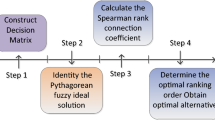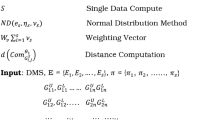Abstract
In this research article, the credibility distribution is defined as a Pythagorean fuzzy restriction, which serves as an elastic constraint on the possible input states of a variable. This definition relates the credibility theory to the theory of Pythagorean fuzzy sets. The current study first defines Cauchy Pythagorean fuzzy numbers and offers a novel method for precise and analytic determination of the inverse credibility distribution. Examples with various degrees of credibility are shown numerically and graphically. Afterwards, we focus on the identification of critical paths in project networks. For this purpose, Pythagorean fuzzy Logic and Multi-Criteria Decision-Making (MCDM) methodologies are combined in a novel structure that is provided to expand the applications of the project scheduling systems. The development of the Pythagorean Fuzzy Program Evaluation and Review Technique (PFPERT), however, was motivated by the vagueness of the time and cost parameters. The primary objective is to find the critical route while considering some decision criteria such as length, duration, cost, resources, and risk factors. All of the criteria are evaluated mathematically based on Pythagorean fuzzy logic and integrated using the VIKOR approach to obtain the resulting critical route. To further clarify the potentials and capabilities of the suggested strategy, the proposed algorithm is successfully examined for a case study related to a greenhouse construction project.

















Similar content being viewed by others
Data availability
No data were used to support this study.
References
Agyei W (2015) Project planning and scheduling using PERT and CPM techniques with linear programming: case study. Int J Sci Technol Res 4:222–227
Akram M, Habib A, Allahviranloo T (2022) A new maximal flow algorithm for solving optimization problems with linguistic capacities and flows. Inf Sci 612:201–230
Akram M, Habib A, Alcantud JCR (2021a) An optimization study based on Dijkstra algorithm for a network with trapezoidal picture fuzzy numbers. Neural Comput Appl 33:1329–1342
Akram M, Habib A, Deveci M (2023a) Application of critical path method in epropertywatch plan using Gaussian Pythagorean fuzzy numbers. IEEE Trans Fuzzy Syst. https://doi.org/10.1109/TFUZZ.2023.3321720
Akram M, Habib A (2023) Hybridizing simulated annealing and genetic algorithms with Pythagorean fuzzy uncertainty for traveling salesman problem optimization. J Appl Math Comput 69:4451–4497
Akram M, Kahraman C, Zahid K (2021b) Group decision-making based on complex spherical fuzzy VIKOR approach. Knowl Based Syst 216:106–793
Akram M, Nawaz HS, Deveci M (2023b) Attribute reduction and information granulation in Pythagorean fuzzy formal contexts. Expert Syst Appl 222:119–794
Akram M, Ramzan N, Deveci M (2023c) Linguistic Pythagorean fuzzy CRITIC-EDAS method for multiple-attribute group decision analysis. Eng Appl Artif Intell 119:105–777
Akram M, Ullah I, Allahviranloo T, Edalatpanah SA (2021) LR-type fully Pythagorean fuzzy linear programming problems with equality constraints. J Intell Fuzzy Syst 41:1975–1992
Akram M, Zahid S (2023) Group decision-making method with Pythagorean fuzzy rough number for the evaluation of best design concept. Granul Comput. https://doi.org/10.1007/s41066-023-00391-0
Amiri M, Golozari F (2011) Application of fuzzy multi-attribute decision making in determining the critical path by using time, cost, risk, and quality criteria. Int J Adv Manuf Technol 54:393–401
Atanassov KT (1983) Intuitionistic fuzzy sets. VII ITKRs Session, Sofia, Deposed in Central Science Technology Library of Bulgarian Academy of Science 1697/84
Carr V, Tah JHM (2001) A fuzzy approach to construction project risk assessment and analysis: construction project risk management system. Adv Eng Softw 32:847–857
Chanas S, Zielinski P (2001) Critical path analysis in the network with fuzzy activity times. Fuzzy Sets Syst 122:195–204
Chanas S, Kamburowski J (1981) The use of fuzzy variables in PERT. Fuzzy Sets Syst 5:11–19
Chen SP (2007) Analysis of critical paths in a project network with fuzzy activity times. Euro J Oper Res 183:442–459
Chen SM, Chang TH (2001) Finding multiple possible critical paths using fuzzy PERT. IEEE Trans Syst Man Cybern 31:930–937
Chen SP, Hsueh YJ (2008) A simple approach to fuzzy critical path analysis in project networks. Appl Math Model 32:1289–1297
Chen CT, Huang SF (2007) Applying fuzzy method for measuring criticality in project network. Inf Sci 177:2448–2458
Chen SM, Lee LW (2010) Fuzzy decision-making based on likelihood-based comparison relations. IEEE Trans Fuzzy Syst 18(3):613–628
Chen SM, Wang JY (1995) Document retrieval using knowledge-based fuzzy information retrieval techniques. IEEE Trans Syst Man Cyber 25(5):793–803
Chen SM, Wang JY (2010) Fuzzy forecasting based on fuzzy-trend logical relationship groups. IEEE Trans Syst Man Cyber Part B 40(5):1343–1358
Chen SM, Ko YK, Chang YC, Pan JS (2009) Weighted fuzzy interpolative reasoning based on weighted increment transformation and weighted ratio transformation techniques. IEEE Trans Fuzzy Syst 17(6):1412–1427
Chen SM, Jian WS (2017) Fuzzy forecasting based on two-factors second-order fuzzy-trend logical relationship groups, similarity measures and PSO techniques. Inf Sci 391:65–79
Chen SM, Zou XY, Gunawan GC (2019) Fuzzy time series forecasting based on proportions of intervals and particle swarm optimization techniques. Inf Sci 500:127–139
Dorfeshan Y, Mousavi SM, Mohagheghi V, Vahdani B (2018) Selecting project-critical path by a new interval type-2 fuzzy decision methodology based on MULTIMOORA, MOOSRA and TPOP methods. Comput Ind Eng 120:160–178
Dubois D, Fargier H, Fortemps P (2003) Fuzzy scheduling: modelling flexible constraints vs. coping with incomplete knowledge. Eur J Oper Res 147:231–252
Dubois D, Prade H (1987) The mean value of a fuzzy number. Fuzzy Sets Syst 24:279–300
Fargier H, Galvagnon V, Dubois D (2000) Fuzzy PERT in series-parallel graphs. IN: Ninth IEEE International Conference on Fuzzy Systems. FUZZ-IEEE 2000 (Cat. No. 00CH37063), 2:717-722
Habib A, Akram M (2024) Optimizing traveling salesman problem using tabu search metaheuristic algorithm with Pythagorean fuzzy uncertainty. Granul Comput 9(1):1–29
Habib A, Akram M, Kahraman C (2022) Minimum spanning tree hierarchical clustering algorithm: a new Pythagorean fuzzy similarity measure for the analysis of functional brain networks. Expert Syst Appl 201:117016
Huynh VN, Nakamori Y, Lawry J (2008) A probability-based approach to comparison of fuzzy numbers and applications to target-oriented decision making. IEEE Trans Fuzzy Syst 16:371–387
Klir GJ (1999) On fuzzy-set interpretation of possibility theory. Fuzzy Sets Syst 108:263–273
Kuchta D (2001) Use of fuzzy numbers in project risk (criticality) assessment. Int J Proj Manag 19:305–310
Lee-Kwang H, Lee JH (1999) A method for ranking fuzzy numbers and its application to decision-making. IEEE Trans Fuzzy Syst 7:677–685
Li P, Liu B (2008) Entropy of credibility distributions for fuzzy variables. IEEE Trans Fuzzy Syst 16:123–129
Liu B, Liu Y (2002) Expected value of fuzzy variable and fuzzy expected value models. IEEE Trans Fuzzy Syst 10:445–450
Liu P, Chen SM, Wang Y (2020) Multiattribute group decision making based on intuitionistic fuzzy partitioned Maclaurin symmetric mean operators. Inf Sci 512:830–854
Lin HC, Wang LH, Chen SM (2006) Query expansion for document retrieval based on fuzzy rules and user relevance feedback techniques. Expert Syst Appl 31(2):397–405
Luqman A, Akram M, Alcantud JCR (2021) Digraph and matrix approach for risk evaluations under Pythagorean fuzzy information Expert Syst Appl 170:114518
Malcolm DG, Roseboom JH, Clark CE, Fazar W (1959) Application of a technique for research and development program evaluation. Opera Res 7:646–669
Mandal S, Maity K, Mondal S, Maiti M (2010) Optimal production inventory policy for defective items with fuzzy time period. Appl Math Model 34:810–822
Mazlum M, Guneri AF (2015) CPM, PERT and project management with fuzzy logic technique and implementation on a business. Proc Soc Behav Sci 210:348–357
Meng F, Chen SM, Yuan R (2020) Group decision making with heterogeneous intuitionistic fuzzy preference relations. Inf Sci 523:197–219
Mirnezami SA, Mousavi SM, Mohagheghi V (2020) A new interval type-2 fuzzy approach for multi-scenario project cash flow assessment based on alternative queuing method and dependency structure matrix with a case study. Eng Appl Artif Intell 95:103–815
Mishra AR, Chen SM, Rani P (2022) Multiattribute decision making based on Fermatean hesitant fuzzy sets and modified VIKOR method. Inf Sci 607:1532–1549
Monjezi N, Sheikhdavoodi MJ, Basirzadeh H, Zakidizaji H (2012) Analysis and evaluation of mechanized greenhouse construction project using CPM methods. Res J Appl Sci Eng Tech 4:3267–3273
Nawaz HS, Akram M (2023) Granulation of protein-protein interaction networks in Pythagorean fuzzy soft environment. J Appl Math Comput 69:293–320
Nieto-Morote A, Ruz-Vila F (2011) A fuzzy approach to construction project risk assessment. Int J Project Manag 29:220–231
Opricovic S, Tzeng GH (2004) Compromise solution by MCDM methods: a comparative analysis of VIKOR and TOPSIS. Euro J Oper Res 2:445–455
Soni AKASH, Kumar CR, Shrivastava AMIT (2022) Construction Projects Risk Assessment Based on Pert, Cpm and Project Management with Fuzzy Logic Technique. Adv Appl Math Sci 21:5385–5395
Wang X, Kerre EE (2001) Reasonable properties for the ordering of fuzzy quantities I. Fuzzy Sets Syst 118:375–385
Yager RR (2013) Pythagorean membership grades in multicriteria decision making. IEEE Trans Fuzzy Syst 22:958–965
Yager RR, Abbasov AM (2013) Pythagorean membership grades, complex numbers and decision making. Int J Int Syst 28:436–452
Yao JS, Lin FT (2000) Fuzzy critical path method based on signed distance ranking of fuzzy numbers. IEEE Trans Syst 30:76–82
Zadeh LA (1965) Fuzzy Sets. Inf Cont 8:338–353
Zadeh LA (1975) The concept of a linguistic variable and its application to approximate reasoning. Inf Sci 8:199–249
Zadeh LA (1978) Fuzzy sets as a basis for a theory of possibility. Fuzzy Sets Syst 1:328
Zahid K, Akram M (2023) Multi-criteria group decision-making for energy production from municipal solid waste in Iran based on spherical fuzzy sets. Granul Comput 8(6):1299–1323
Zammori FA, Braglia M, Frosolini M (2009) A fuzzy multi-criteria approach for critical path definition. Int J Proj Manag 27:278–291
Zareei A, Zaerpour F, Bagherpour M, Noora AA, Vencheh AH (2011) A new approach for solving fuzzy critical path problem using analysis of events. Expert Syst Appl 38:87–93
Zeng J, An M, Smith NJ (2009) Application of a fuzzy based decision making methodology to construction project risk assessment. Int J Proj Manag 25:589–600
Zhou J, Yang F, Wang K (2016) Fuzzy arithmetic on LR fuzzy numbers with applications to fuzzy programming. J Intell Fuzzy Syst 30:71–87
Author information
Authors and Affiliations
Corresponding author
Ethics declarations
Conflict of interest
The authors declare no conflict of interest.
Authors’ contributions
Amna Habib and Muhammad Akram conceptualized and designed the study, analyzed the data, and wrote the manuscript.
Funding
There is no specific funding for this project.
Additional information
Publisher's Note
Springer Nature remains neutral with regard to jurisdictional claims in published maps and institutional affiliations.
Rights and permissions
Springer Nature or its licensor (e.g. a society or other partner) holds exclusive rights to this article under a publishing agreement with the author(s) or other rightsholder(s); author self-archiving of the accepted manuscript version of this article is solely governed by the terms of such publishing agreement and applicable law.
About this article
Cite this article
Akram, M., Habib, A. A novel Pythagorean fuzzy PERT approach to measure criticality with multi-criteria in project management problems. Granul. Comput. 9, 36 (2024). https://doi.org/10.1007/s41066-024-00461-x
Received:
Accepted:
Published:
DOI: https://doi.org/10.1007/s41066-024-00461-x




